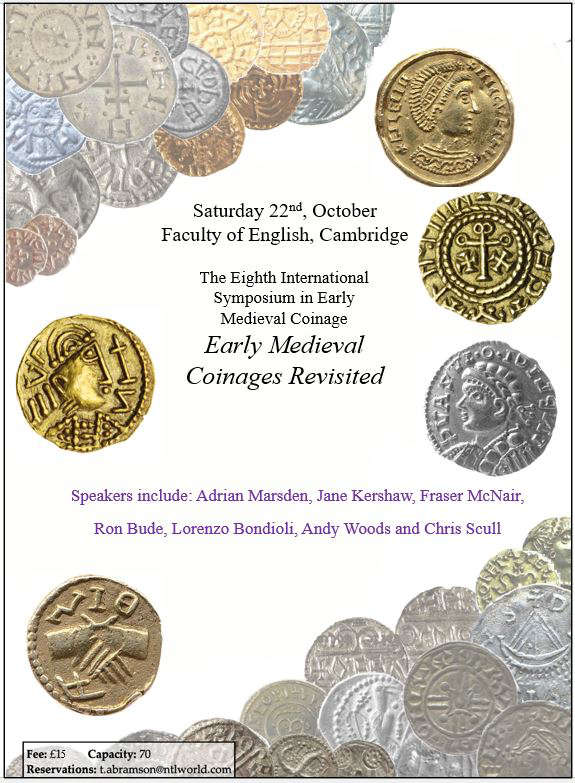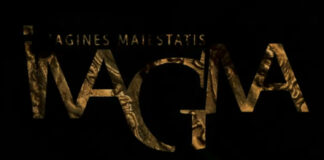The popular biennial series of one-day symposia in early medieval coinage will recommence following lockdown, with a gathering at the Faculty of English, 9 West Road, Cambridge CB3 9DP, on Saturday 22nd October 2022.
Programme
The theme is Early Medieval Coinages Revisited and papers include:
- The West Norfolk Hoard – Adrian Marsden
- Rendlesham, Suffolk: A Central Place, Coinage and Coin-Use in the Sixth to Eighth Centuries:
- Chris Scull: The Elite Settlement Complex at Rendlesham
- Andy Woods: Currency, Coinage and Monetisation in Early Medieval East Anglia: Interpreting the evidence from Rendlesham
- The Coinage of Eadberht of Northumbria – Ron Bude
- Lead isotope analyses of dirhams – silver sources in the Golden Age of Islam – Jane Kershaw
- Tax, Debt, Money, and Coinage: A View from Islamic Egypt – Lorenzo Bondioli
- Money and Political Culture in Ninth-Century Viking Realms – Fraser McNair
Adrian Marsden: The West Norfolk Hoard
A hoard of Byzantine and Merovingian gold coins found in West Norfolk was declared Treasure last November and Norwich Castle Museum is hoping to acquire it. The 132 solidi and tremisses and the associated gold items make this an internationally important hoard and its constituent coins have come from all corners of Merovingia and beyond. Study of the hoard is ongoing and more pieces will surely surface in the future; here we tell the story of the hoard’s discovery and consider the assemblage as a whole and how it relates to other finds of a similar date.
Rendlesham, Suffolk: a Central Place, Coinage and Coin-Use in the Sixth to Eighth Centuries
Christopher Scull: The Elite Settlement Complex at Rendlesham
Understanding of the East Anglian royal centre at Rendlesham has developed since we last presented to this conference in 2018, with analysis undertaken through the project Lordship and Landscape in East Anglia, funded by the Leverhulme Trust, and excavations undertaken as part of the community archaeology project Rendlesham Revealed, funded by the National Lottery Heritage Fund. In these linked presentations we examine 1) the site, the range of activities undertaken there, and its role as the focal place of an extensive region in the sixth to eighth centuries; and 2) the coin assemblage from the site, and the developing patterns of coin use in their local and regional contexts.
Andrew Woods: Currency, Coinage and Monetisation in Early Medieval East Anglia: Interpreting the evidence from Rendlesham
This paper will trace the networks of exchange of which Rendlesham was a part, as well as interpreting the nature of coin use at the site. It will be argued that both shifted rapidly in this period, with the former transformed from networks which extended out into the Mediterranean world to those focused upon the East Anglian kingdom. In the case of the latter, I will argue that Rendlesham was in the vanguard of Early Medieval coin use in East Anglia, acting as a catalyst across the kingdom.
Ron Bude: The Coinage of Eadberht of Northumbria
The results of a comprehensive die analysis of the prolific coinage of Eadberht of Northumbria (737-758) examining the sequencing of types, the significance of the find site and other intriguing research findings.
Jane Kershaw: Lead isotope analyses of dirhams – silver sources in the Golden Age of Islam
This talk presents new lead isotope data for over 200 dirhams, minted is the early Islamic period (Umayyad and Abbasid). The data cast fresh light on silver sources within the Caliphate, overturning the current view that silver was sourced predominantly in the Arabian Peninsula and in Khorasan. Instead, I will argue for a regional pattern of silver mining, with silver moving from mine to mint within North Africa, Iraq, Iran and Transoxania. This, in turn, has potentially profound implications for the history of the Islamic world.
Lorenzo Bondioli: Tax, Debt, Money, and Coinage: A View from Islamic Egypt
The paper will focus on Islamic Egypt, roughly between the late ninth and the eleventh centuries, discussing the relationship between money of account, paper payment instruments, and actually minted coinage. The paper will highlight the different but interlocked functions that each of these money forms played in the two distinct, yet overlapping, spheres of state taxation
Fraser McNair: Money and Political Culture in Ninth-Century Viking Realms
As Scandinavian and Scandinavian-derived groups began founding their own polities across Europe in the ninth century, they encountered many different kinds of money, from the Frankish currency of Dorestad to the imitation dirhams of Khazaria. As these groups settled into their roles as elites outside of the Scandinavian peninsula, they had to adopt, adapt or reject the monies they found. This paper will examine part of this process, looking with a comparative perspective at the roles that money and bullion played in the ideological underpinnings of Northman rule in Dublin, East Anglia, Frisia and the early Rus’ polity/polities, and present the initial findings of this research and commercial capital circulation.
Reservations for the 2022 conference can be done via email.




